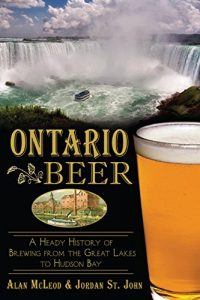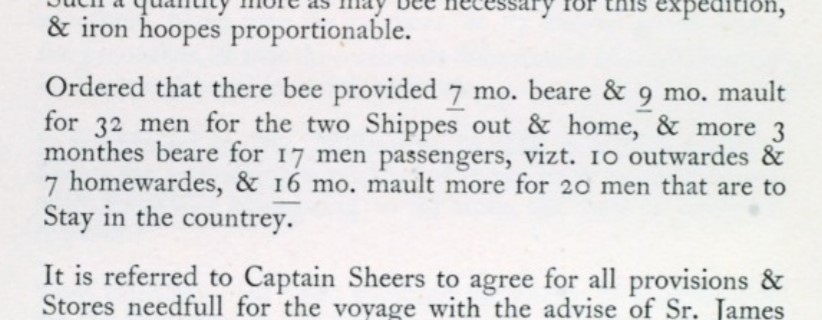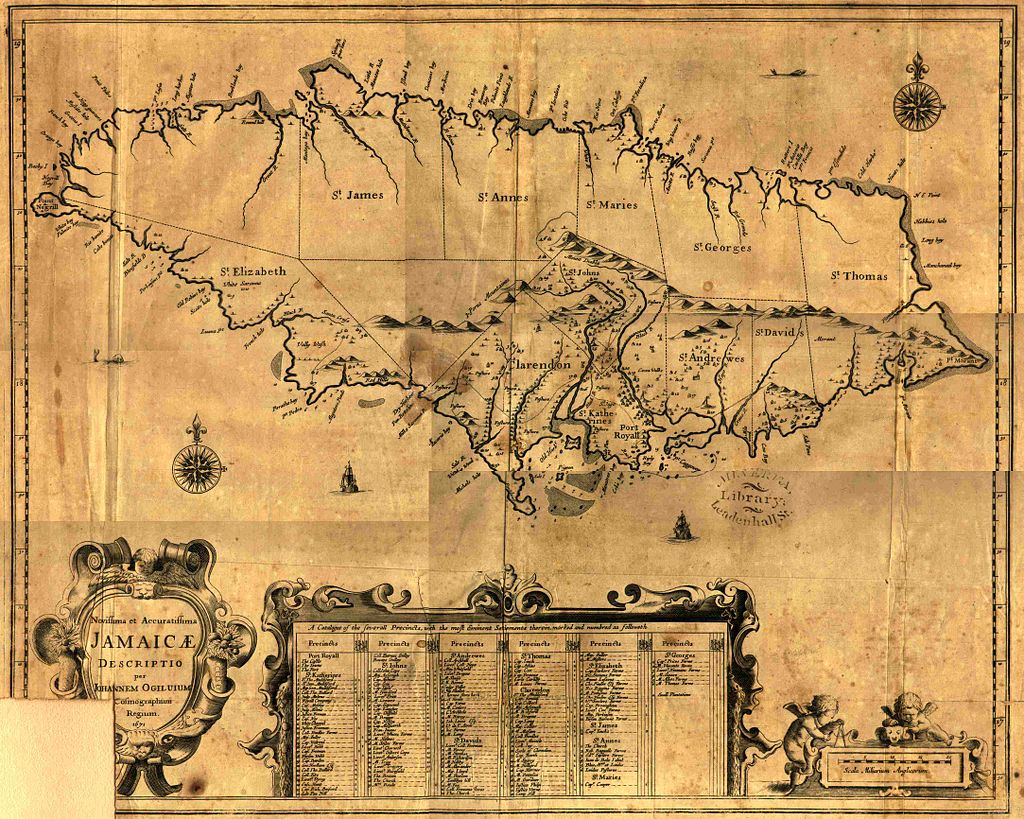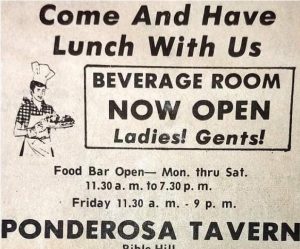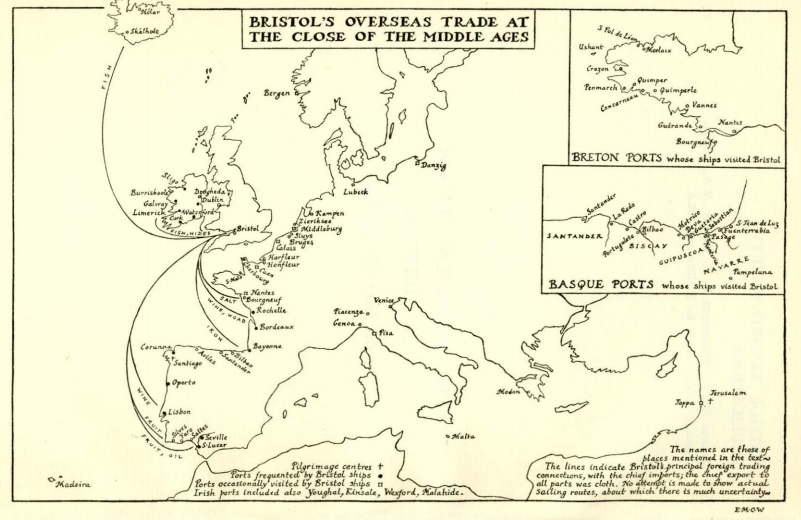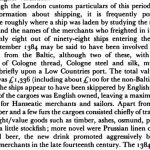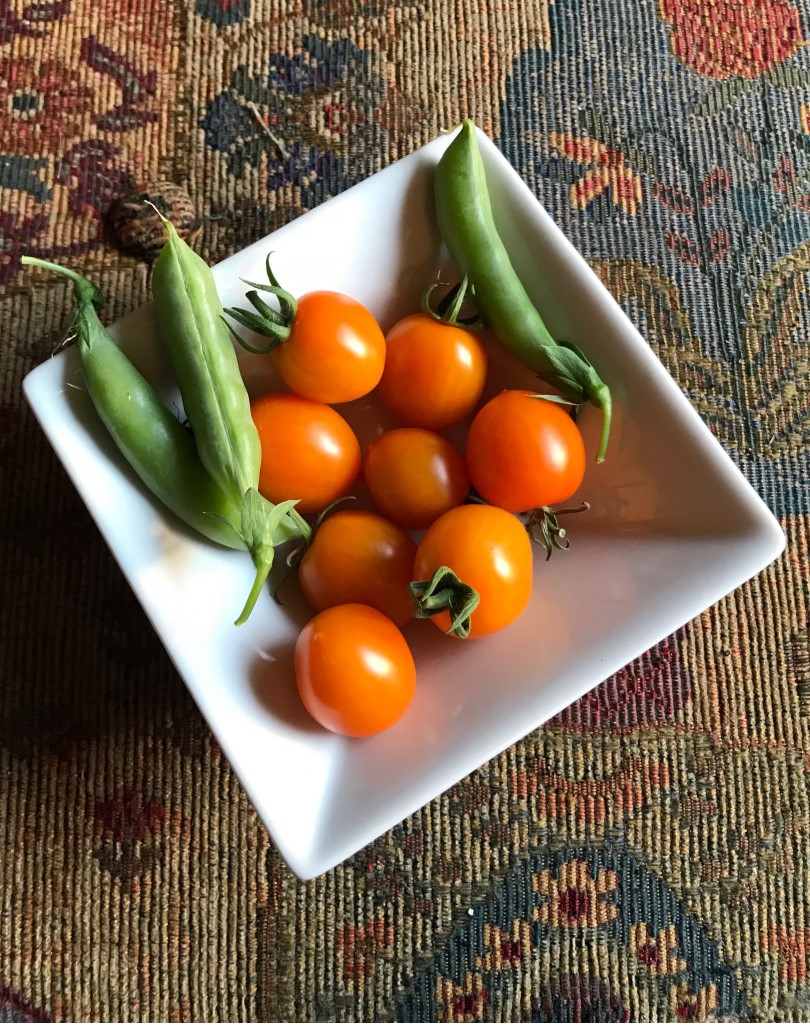 Here I am! Thursday morning once again. And the whole world of beer and brewing… and photos of vegetables. It’s what you demand. I know. I hear you. That’s an Orangello plum tomato from Chiltern right there. Just six seeds to the pack and everyone a winner. Super productive and tasty. Seed influencer opportunities most welcome. Katie Mather is eating her veg, too, as we read about in this week’s feature in Pellicle:
Here I am! Thursday morning once again. And the whole world of beer and brewing… and photos of vegetables. It’s what you demand. I know. I hear you. That’s an Orangello plum tomato from Chiltern right there. Just six seeds to the pack and everyone a winner. Super productive and tasty. Seed influencer opportunities most welcome. Katie Mather is eating her veg, too, as we read about in this week’s feature in Pellicle:
Eating salads, for me, has been a radical act: buying fresh food, taking the time to prepare and pre-prepare meals, encouraging myself to eat and to feel good about eating. Learning how to make bowls of healthy, nourishing vegetables and herbs so delicious that I don’t think twice about devouring them. I’ve been steadily unlearning my aversion to salad dressings, and my unhealthy belief that unless they are low-calorie, salads are worthless.
Exactly. All veg is worthy. Is anything else happening out there, things not in my garden? Other than, you know, famous pubs surprisingly burning to the ground days after being sold off… what’s that you say? Here’s the update:
An update post on the pub’s Facebook page on 27 July said: “The Crooked House has been sold. Unlikely to open its doors again. Marston’s have sold the site to private buyer for alternative use, that is all we know. This is just to update the page so nobody makes any wasted journeys to the site.” A petition to save the pub from redevelopment, launched on 29 July, had attracted more than 3,500 signatures. Andy Street, mayor of the West Midlands, said there were “a lot of questions” surrounding the fire. “I’m sure the authorities will get to the truth,” he said.
The BBC has visited in happier times. There are rumours that the path of the fire trucks to the site was somehow obstructed leading to suspicions piled upon suspicions: “… blocking off of the lane to the pub seems to indicate a deliberate act.” Police have been on scene. Jings! I say no more.
In almost as disasterous legal news, ye who lives by the sword apparently dies by the sword as whatever is left of California’s former craft darling Stone has lost a tradename court case in Europe to Molson Coors, owners of of the venerable Stones bitter brand – making some extraordinary and entirely unaccepted claims:
Among them was a claim that Molson Coors had not provided “sufficient evidence of genuine use” of the Stones bitter brand – which has been around since 1948 and which was the sponsor of Rugby League and The Superleague in the 1980s and 1990s… that was rejected, along with the claim that “the element ‘Stones’ of the earlier (Molson Coors-owned) trademark will be perceived by a part of the English public as the music band ‘The Rolling Stones’ or the surname ‘Stones’, whereas the trademark applied for Stone Brewing is perceived a reference to the object ‘ stone’.”
Speaking of Molson, to my east… perhaps… Gary has been writing about mid-century brewing marketing from Quebec in a series of posts like this one focusing on 1939-40 advertising including one from Molson with this eye-catching slogan:
The campaign tied into a longstanding advertising theme at Molsons, “The beer your great-grandfather drank.”
Yum… beer flavours from the mid-1800s… Now, on the topic of what your great-grandfather wouldn’t be drinking, The New Yorker has a piece this week on something recently noticed in France:
Recently, in Paris, posters appeared all over town advertising an unfamiliar beverage: vière. “Du jamais bu,” one poster punned—“Never before drunk.” It came in a seven-hundred-and-fifty-millilitre glass bottle, just like a Chablis or a Marsannay. The bottle had a metal cap, the kind you might pry off the top of a Heineken. “It’s not a typo,” Gallia, the drink’s manufacturer explained, on its Web site, of “vière,” adding that “we wanted to switch things up by combining two malts that we love.” Vin (wine) + bière (beer) = vière.
Really? Perhaps you would prefer a citron presse instead? Simple. Perhaps something your great-grandfather would enjoy.
Update: Jessica Mason (who totally wins this week’s best humoured approach to rudeness award) reports that the young folk love cask but they are clueless… dimmer than a 25w lightbulb and just can’t find it in a pub!
Speaking to the drinks business, the ‘Drink Cask Fresh’ campaign coordinator Pete Brown said: “The industry talks it [cask ale] down way more than the drinker does. No one ever says it’s old fashioned or geeky or old men in socks and sandals. We say it to each other. Younger drinkers don’t.” Brown explained: “It’s not just about how tall the font is – the badge at eye level is handy but you can’t have two and a half foot long hand pulls. But even Guinness with its new font is now poured just below eye level. Cask is the only beer poured beneath the bar where you can’t see what’s going on and this greatly adds to the uncertainty around it.”
Not sure I believe that… but beer writers interviewing beer writers is on the rise, however.*** Yet also not sure I believe this either. Paste is having none of the sort of thinking that leads us to kiddie cask campaignning and vière, instead joining the death of craft pile-on and pronounced upon the scene thusly:
Welcome to the spiritual ennui of the beer world, a problem at least partially separate from the myriad economic factors that have made it so daunting to run a successful small brewery in this day and age. On the most basic level, the craft beer landscape has simply felt trapped in stylistic stasis in recent years, a far cry from the previous era of new discovery and growth that was fueled in the 2000s and 2010s by a market in which it was so much easier to turn a profit. This stagnation has no doubt played some role in the migration of craft beer drinkers to other segments of the alcohol world…
Moving on. Have you? Perhaps relatedly, no wonder Ron has joined the masses of people (as discussed just last week) who are questioning why they ever every got at all interested in beer now that it is (i) not cool and (ii) fruit juice with a malt base:
There are so many parallels with the real ale movement. Kicking off with, mostly, very excited young people who want to change the (beer) world. Slow beginnings, followed by intoxicating, seemingly never-ending, growth. Then you look around and you’re all in your forties. And those young people, they just don’t understand what good beer is. They like some new nonsense, that isn’t proper beer. Not like the stuff you love. “Your beer is boring.” Youth says. “We want something new and exciting. Not that old man beer.”
Old man beer? What’s wrong with that? Isn’t that what your great-grandfather drank? Speaking of one form of that – and despite all the recent Guinness love – this may be reason enough to boycott the stuff and all Diagio products:
But is it? Are these all bootlegged products smuggled infrom third countries? Is Heineken not the worse offender?
Heineken Russia launched an Irish stout last year after Guinness was withdrawn from the country following the invasion of Ukraine. In March 2022, the Dutch drinks giant said in that it would join other western brands in withdrawing from Russia following the invasion. However, it maintained a local business that has developed products after it withdrew the Heineken, Miller and Guinness brands. The company makes Miller and Guinness in Russia under third party licences.
Or is it Carlsberg? Questions questions questions. I ask all these questions as, frankly, I am not paying the fee to look behind the paywall.** But they are great questions, you will agree! Speaking of questions being asked, Greene King Abbot Ale came second in the race to be named the Champion Beer of Britain… and people went nutso… as reported in the measured tones of The Sun:
Angry real ale fans are all frothed up amid claims a champion beer contest was rigged. They are questioning how sponsor Greene King’s Abbot Ale won a coveted silver medal at this year’s Great British Beer Festival. The Suffolk brewer’s pub staple was also named the UK’s best premium bitter. Greene King is one of two backers of the festival, along with the JD Wetherspoon pub chain — where Abbot Ale is one of the biggest sellers. Drinkers at London’s Olympia venue were outraged at the vote by the Campaign for Real Ale. Beer blogger Mark Briggs, of Burnley, fumed: “I suspect some unfair influential intervention.
Mr. Briggs appears to write a column for a chain including the Lancashire Telegraph given sa bazillion links pop up for the same story so perhaps it should be beer columnist, beer connoisseur and passionate pub campaigner.* I am of the “get a goldfish!” persuasion in such matters so congrats to this mid-range and accessible brewery for put out a pretty good product. Some beer nerds just need to get a life. And as for doubts as to the definitive authority of a beer judging contest – what the hell do you expect? The ever reliable Ed was even on the scene of the incident:
…the next day was a bit of a struggle it was brightened by the return of twerps whinging on about the GBBF on twitter, this time because Abbot Ale got overall second place in the CBoB. CAMRA and the blind tasting panel are in the pay of Greene King it seems. Which I suppose makes a change from Wetherspoons. To me the twerps are just showing their ignorance. The wonder of cask beer means that at times it can elevate beers to highs you would never have expected. If people spent less time suckling at the devil’s drainpipe and more time drinking beer served as god intended they would realise this.
Martin went out and about looking for some to make up his own mind: ” sadly it’s a bit dull and “milky” (NBSS 2.5)… 2.5 is the level at which you don’t take a beer back, you just decide NEVER to try cask again.”
Things I did not know until this week #1. Sir Walter Raleigh brewed a beer in Virginia in 1585 – and it was made of corn:
…the same in the West Indies is called MAIZE: English men call it Guinea wheat or Turkey wheat, according to the names of the countries from whence the like has been brought. The grain is about the bigness of our ordinary English peas and not much different in form and shape: but of divers colors: some white, some red, some yellow, and some blue. All of them yield a very white and sweet flour: being used according to his kind it makes a very good bread. We made of the same in the country some malt, whereof was brewed as good ale as was to be desired. . .
Not the oldest beer in North America as eight years early that came to what is now Baffin Island in the Canadian Arctic care of the 1577 mission of Sir Martin Frobisher, spending a summer for the English navy mining for ores some of which may have ended up in the superior cannon that destroyed the Spanish Armada. Neato. But is this new find the first beer brewed in the hemisphere or even the actual first beer? I know that Cartier brought wine and cider in his hold in the 1530s as was drunk in the 1520s off Newfondland. Still looking for Cabot‘s records from almost 100 years before Raleigh’s trip.
More recently, we learned this week from Boak and Bailey that 1860s London barman Thomas Walker was born Mary Anne Walker – and moved between those identities for a number of years:
Once he had become famous, this became more difficult. Throughout the late 1860s, newspapers delighted in reporting that ‘the female barman’ had been found out again, and taken to court. Eventually, he made some attempts to capitalise on his reluctant fame. In 1870 he went into business with one Solomon Abrahams with the idea of being the celebrity landlord of a pub in Shoreditch. Walker ended up in court again after a dispute over the takings with Solomon. (Lake’s Falmouth Packet and Cornwall Advertiser, 15 January 1870.) Eventually, perhaps having run out of options, in the 1870s, Thomas began performing as Mary Walker, “the original Female Barman”, on the music hall stage.
Back to the present, in health matters CNN published a commentary on a study published by The Journal of the American Medical Association indicating an unbalanced increase in mortality from alcohol use:
According to this research, from 2018 to 2020, women saw a 14.7% increase in alcohol-related deaths, compared to a 12.5% increase among men. And the shift was also pronounced among individuals 65 and older, where there was a 6.7% increase in alcohol-related deaths among women, compared to a 5.2% increase among men… There is also the simple fact that Americans have long had a deeply dysfunctional relationship with booze, and as women have moved toward greater equality with men — and lived lives that look more like men’s — women are engaging in more alcohol-related dysfunction.
Really? And what to make of some of the negative news out there when the European Union has declared that beer production has now returned to pre-pandemic levels?
In 2022, EU countries produced almost 34.3 billion (bn) litres of beer containing alcohol and 1.6 bn litres of beer which contained less than 0.5% alcohol or had no alcohol content at all. Compared with 2021, the production of beer with alcohol in the EU increased by 7%, returning to levels closer to the pre-pandemic year of 2019, when production was at 34.7 bn litters. When it comes to beer without alcohol, there was no change compared with 2021. The EU’s total beer (with and without alcohol) production in 2022 was equivalent to almost 80 litres per inhabitant.
Something is selling… but what? Is it just that we want comfort beer in these times of uncertainty? I’ve buy that. If you think about it, isn’t that what identi-craft hazy fruit flavoured IPA are? As much as macro lagers are labeled? Is it what is on the plate next to the comfort beer that really matters, like this rural Australian pub has discovered?
In between pulling beers at the bar and serving fine South Australian wines in the adjoining dining room, Sanne passes me the wildlife-driven menu I’d travelled all this way to see, where I gamely order the specialty of the house – the feral mixed grill – a challenging plate sporting such non-everyday delicacies as emu rissoles, kangaroo fillet, goat chops and camel sausage. Dismissing the momentary reservation I might in fact be devouring a petting zoo – when the dish arrived, it was absolutely delicious – beyond delicious in fact – my favourite, I think, was the goat chop.
Mmm…. feral mixed grill… great-grandpas likely tucked into that once in a while, too. And – that is it! And as per ever and always, you can check out the many ways to find good reading about beer and similar stuff via social media and other forms of comms to connect – even including at my new cool Threads presence @agoodbeerblog. Have you checked out Threads as Twitter ex’s itself? (Ex-it? Exeter? No that makes no sense…) They appear to achieved to make social media offer less and less. Brilliant… but I never got IG either. I still prefer the voices on Mastodon, any newer ones noted in bold:
Alan McLeod | A Good Beer Blog (… me…)
Stan Hieronymus | The Man!
Boak & Bailey | The B² experience
Curmudgeon Ale Works | Jonathon is Brewing
Katie Mather | Shiny Biscuit and Corto
David Jesudason | “Desi Pubs” (2023) author
BeoirFest | They say “Let’s Talk Beer”
Ron Pattinson | The RonAlongAThon Himself
Al Reece AKA Velky Al | Fuggled
Jennifer Jordan | US hops historian
Andreas Krennmair | Vienna beer and lager historian
Beer Ladies Podcast | Lisa Grimm and colleagues
The Bar Towel | Toronto’s chat zone for beer lovers
Chicago Beer Society | Folk in Chicago getting social over beer
Jay Brooks | Brookston Beer Bulletin
Joe Stange | Belgian beer expert, beer magazine editor
Cider Bar | Barry makes Kertelreiter cider
Laura Hadland | CAMRA historian and beer writer
Brian Alberts | US beer historian
Jon Abernathy | The Beer Site
Maureen Ogle | US Beer Historian
Lars Garshol | Norwegian Beer Historian and Kveik Hunter
James Beeson | Beeson on Beer
Carla Jean | MAINER!!!
Thandi Guilherme | Beer Ladies Podcast Co-host
Lisa Grimm | Beer Ladies Podcast Co-host
Roy of Quare Swally | Beery ramblings from Northern Ireland
Rob Talksbeer | Podcaster and Youtuber
Anthony Gladman | UK Drinks Writer
Jeff Alworth | Manna Of Beervana
Northwest Beer Guide | Fairly self explanatory… but not NW Latvia…
Evan Rail | Prague based GBH editor, freelance writer, NYT etc.
Todd Alström | 50% of the Alströms
Jacob Berg | Beer talking librarian
Anyone else? And, yes, we also check the blogs, podcasts and newsletters to stay on top of things – including more weekly recommendations from Boak and Bailey every Saturday and Stan at his spot on those Mondays! Get your emailed issue of Episodes of my Pub Life by David Jesudason on many Fridays. And Phil Mellows is at the BritishBeerBreaks. Once a month, Will Hawkes issues his London Beer City newsletter and do sign up for Katie’s now more occassional but always wonderful newsletter, The Gulp, too. Ben’s Beer and Badword is back! And check out the Atlantic Canada Beer Blog‘s weekly roundup. There is new reading at The Glass. Any more? Yes! Check to see the highly recommended Beer Ladies Podcast. And the long standing Beervana podcast . There is the Boys Are From Märzen podcast too and check out the travel vids at Ontario’s own A Quick Beer. There is more from DaftAboutCraft‘s podcast, too. All About Beer has introduced a podcast. There’s also The Perfect Pour. Plus follow the venerable Full Pint podcast. And the Craft Beer Channel on Youtube soon celebrating a decade of vids. And remember BeerEdge, too, and The Moon Under Water… if you have $10 a month for this sort of thing… I don’t. Pete Brown’s costs a fifth of that. There was also the Beer O’clock Show but that was gone after a ten year run but returned renewed and here is the link!
*…and draftsman of some pretty ripe prose: “It presented itself foggy golden in colour. The aroma being certainly intense, as I expected. Peach, lemon-citrus, passion fruit and some piney notes were all identified. There was a sublime flavour explosion of more juicy, peach, passion fruit and lemon-citrus on the palate. Some floral, subtle spice, pine and soft, caramel malt sweetness were also tasted; in this beautifully balanced, Simcoe and Loral Cryo hopped beer. More tropical fruit, lemon-citrus and a hint of spicy warmth, in the crisp and long, drying finish.” Lordy!
**It’s not like I’m speading money on just anything for your pleasure reading, you know. Look at this, for example. Clearly a botch on the meaning of the meaninglessness of “craft”… yet there it is. Does one pursue the question? No, because it is going to be public knowledge in 73 hours. It always is. Make that… two: “Upon satisfaction of customary closing conditions, Tilray will acquire Shock Top, Breckenridge Brewery, Blue Point Brewing Company, 10 Barrel Brewing Company, Redhook Brewery, Widmer Brothers Brewing, Square Mile Cider Company, and HiBall Energy. The transaction includes current employees, breweries and brewpubs associated with these brands. The purchase price will be paid in all cash and the transaction is expected to close in 2023… the acquired brands will elevate Tilray Brands to the 5th largest craft beer business position in the U.S., up from the 9th…” Canadian whacky tobakky firm buys tired old dull brands… why? Jeff has more. Note: I do pay for The New Yorker. All the funny cartoons and those fabulous “Tables for Two” columns are worth every penny.
***Sort of the old self-sustaining adver-news-a-torial thingie I suppose… in The Lion King wasn’t this called “The Circle of Life”? Yet… if how Pete… who will say these things? PS: do you like the chronological appoach to footnotes instead of the traditional sequential? I’m experimenting. Send a telex with your thoughts.
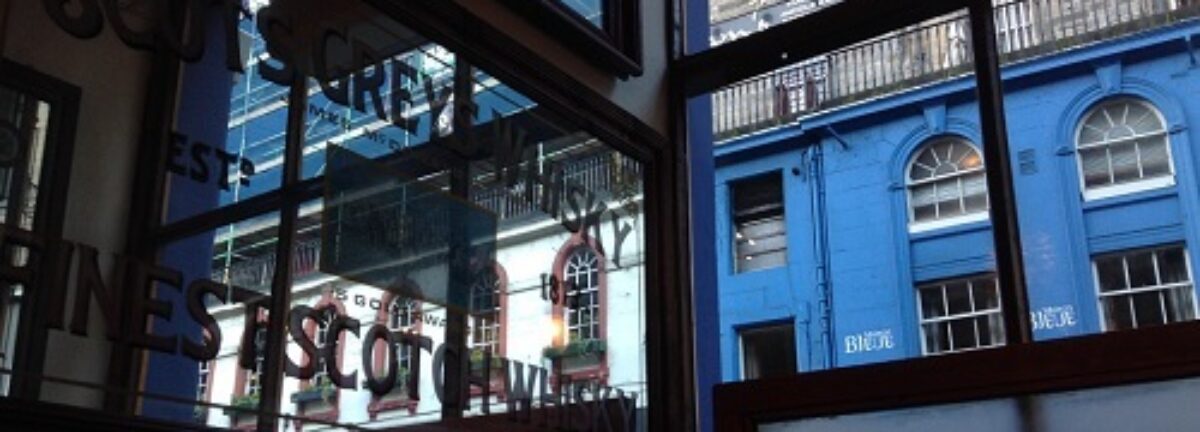
 Beer snake! Never seen one from that point of view before. Thanks to beer and baseball specialist
Beer snake! Never seen one from that point of view before. Thanks to beer and baseball specialist  : not Pete’s best photo… that is Pete, right? And grey? Really. Talk about yer dreich! No… not Pete… no, the logo’s background!!****
: not Pete’s best photo… that is Pete, right? And grey? Really. Talk about yer dreich! No… not Pete… no, the logo’s background!!****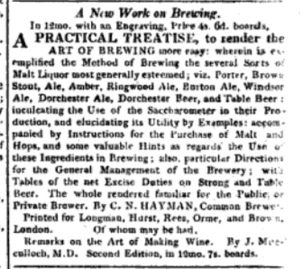
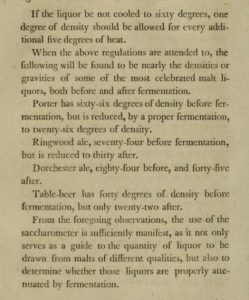
 In an
In an 